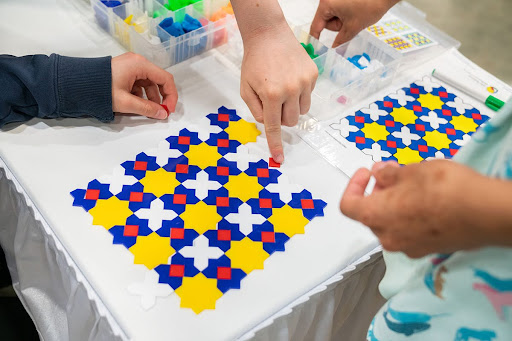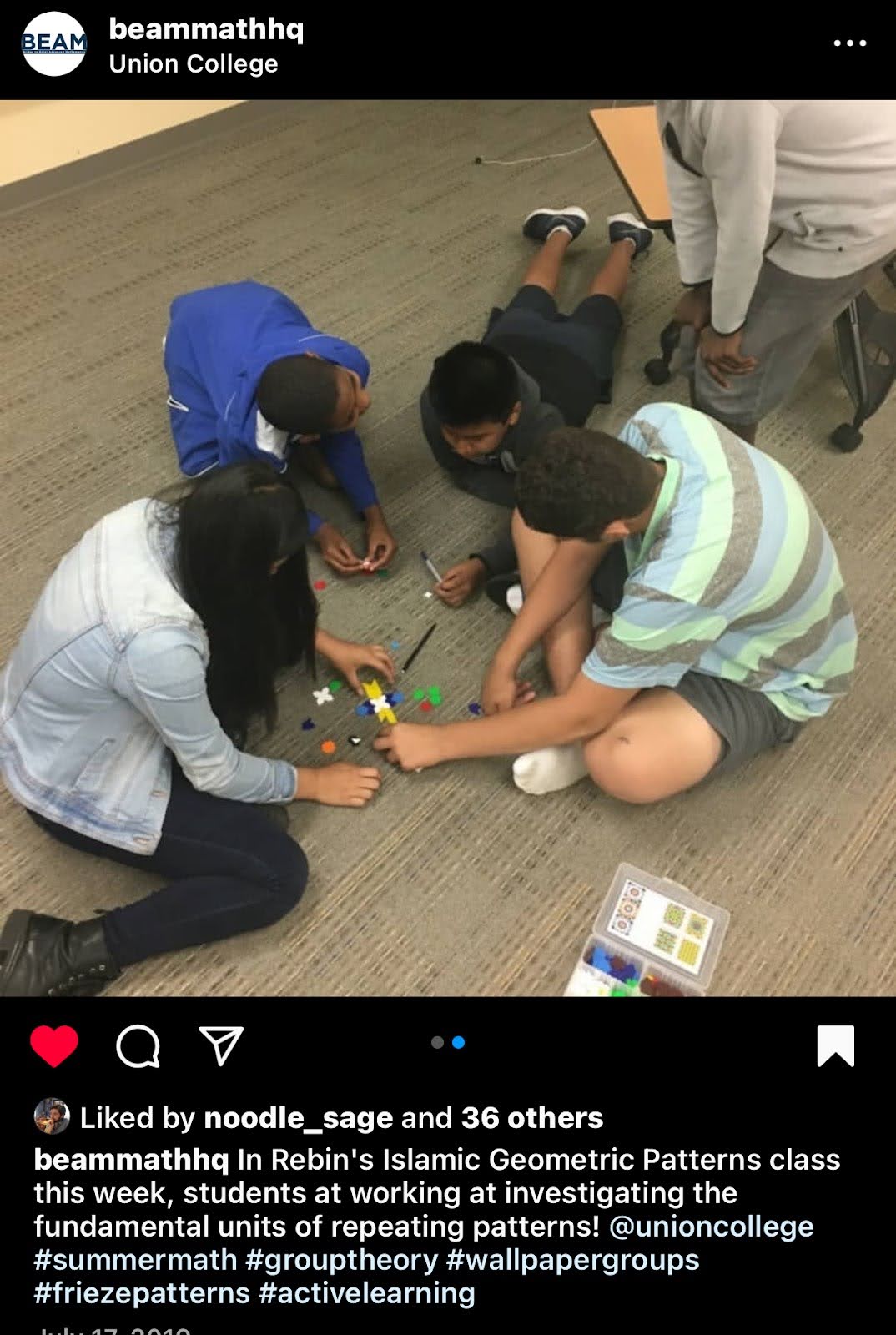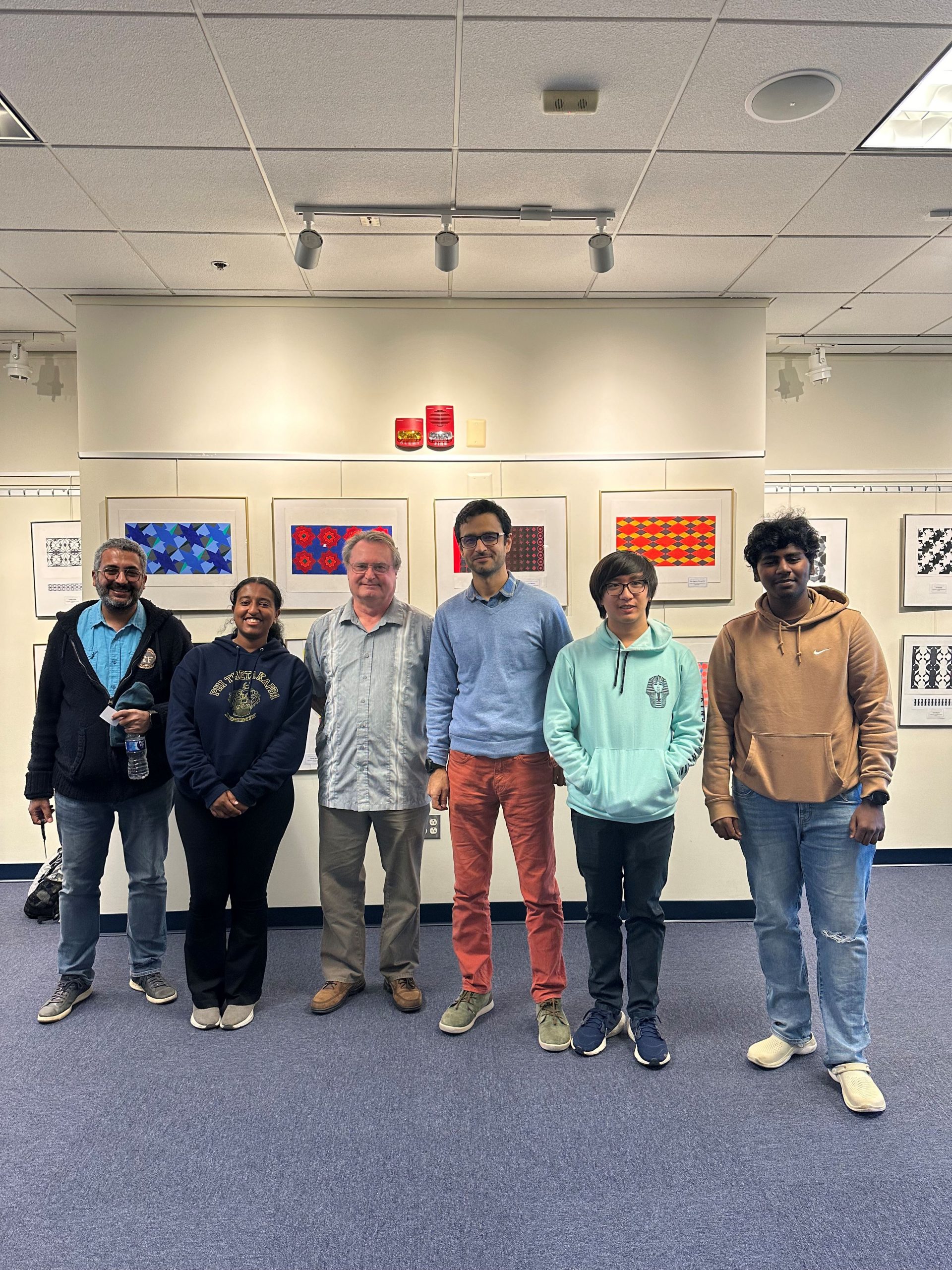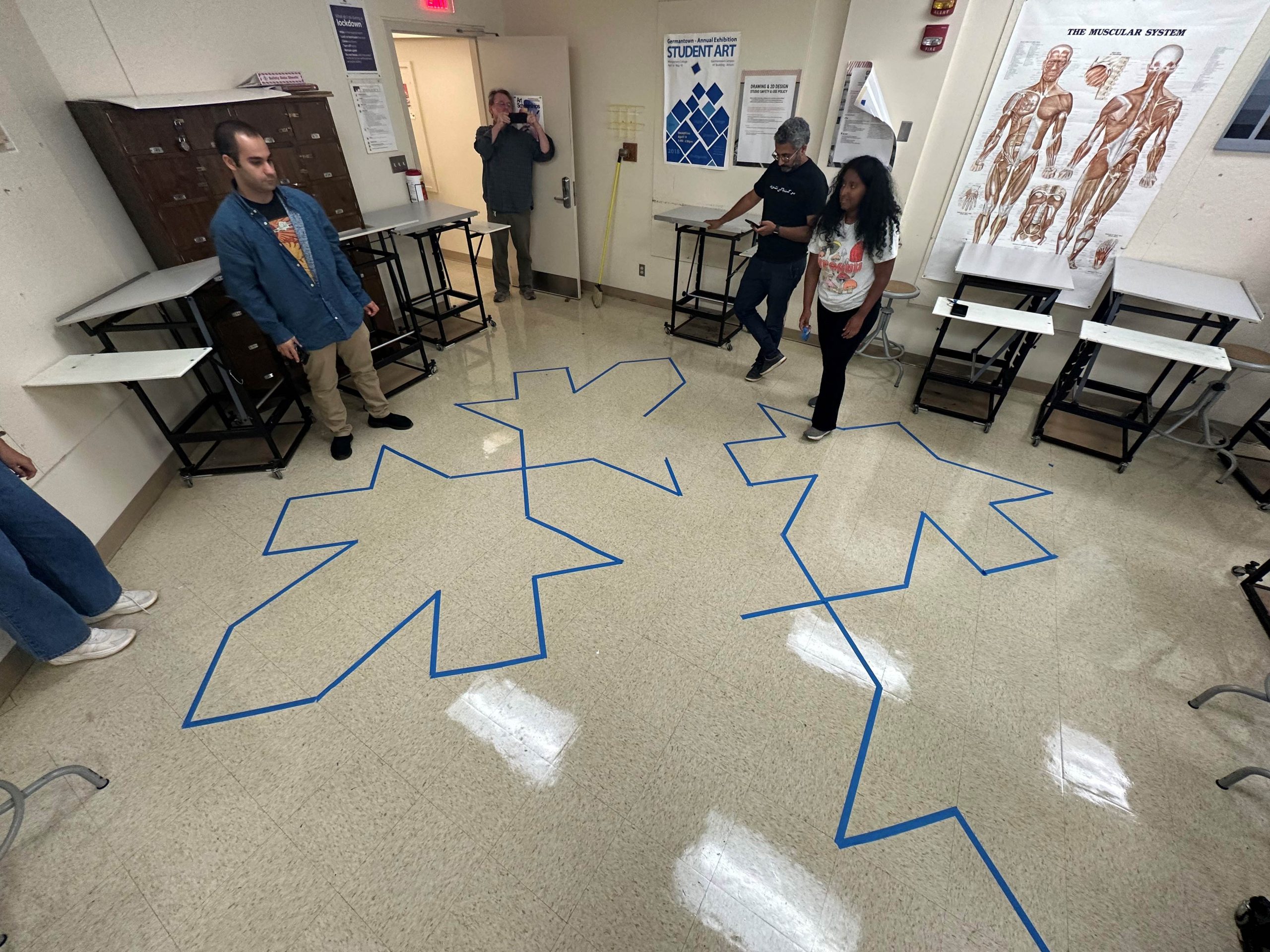Math and Art in Islamic Geometric Patterns: Creating and Teaching in Collaboration
By Rebin Muhammad, Ph.D.
In first grade when I was in Iraq, I took my first art class. Given that my parents weren’t well-educated, and my dad was embroiled in the Iran-Iraq war, art had never been a part of our home life. I do not recall that we ever had colored pencils while I was in elementary school. I still remember during my first art class, my teacher insisted that I draw something and even threatened punishment if I didn’t comply, but I did not know what to draw or how to draw. This was the moment that I felt I was not an “art person,” and that feeling stayed with me until graduate school. I loved art, but I felt it was something beyond my reach.
In 2012, I moved to the U.S. and began my Ph.D. in math. I was exposed to new ideas, and I took every opportunity to enrich my academic and personal life. I participated in outreach programs in my community such as Math Night and Math Circle. I regularly visited museums and art exhibitions. Then, an interesting accident happened in 2017. While scrolling through Instagram, I stumbled upon some captivating Islamic Geometric Patterns. I was intrigued. These patterns were highly mathematical but also had a very artistic flavor. This discovery was particularly striking as I had spent time in regions renowned for such patterns, yet the chaos of conflict had overshadowed my appreciation for their beauty. It’s a poignant reminder of how turmoil can eclipse the cultural and mathematical heritage right before our eyes.
The people who create these patterns call themselves Islamic Geometric Pattern (IGP) artists or geometers. Islamic geometric patterns are a form of artistic expression that has been a prominent part of Islamic art (there are two other forms of Islamic art: floral and calligraphy). The patterns are created using a set of basic shapes—mainly circles, squares, and polygons, to form complex and intricate designs. These patterns often consist of tessellations where a plane is filled with a repeating pattern without any gaps or overlaps. Historians believe that Islamic Geometric Patterns became prevalent because Islam discourages depicting living figures, leading artisans to develop these patterns as an alternative for embellishing structures like mosques.
I started following Islamic geometric artists and began creating patterns myself, like the Khatam of Sulayman, using basic tools such as a compass and ruler. At first, I wasn’t sure about the traditional rules for coloring these designs, so I simply chose colors that appealed to me, which brought me to the world of watercolors. I picked up the craft at age 36, beginning with basic supplies. As I became more invested, I realized the need for higher-quality materials. An artist friend suggested a specialized art supply store for top-notch paints, brushes, and paper; I drove an hour to reach it and purchase the new materials. It was quite a shift for me, spending a considerable amount of money on art supplies, but it marked the exciting start of a new creative journey.
Sharing IGP with the community
 Soon thereafter, I began sharing IGP—I felt it was too good to keep it to myself. In 2016, during the time when the Muslim Travel Ban was enacted, I began sharing my newfound hobby with others. During a weekend math event in Athens, Ohio, called “My Circle,” I presented my work on Islamic Geometric Patterns. Many people showed up, some of them, I believe, solely to support Muslims. After receiving so much positive feedback and, due to the political climate in the U.S. during those times, I felt an urgency to bring activities from a different part of the world and culture to people in the U.S. This led to even more opportunities, such as participating in the Julia Robinson Math Festival in Columbus, Ohio (Some pictures from the event can be found at the bottom of this page). To my delight, the event drew many attendees, both kids and adults, to my activity station. Surprisingly, this was a national trend too; more books about Islamic Geometric Patterns started to appear than at any time before.
Soon thereafter, I began sharing IGP—I felt it was too good to keep it to myself. In 2016, during the time when the Muslim Travel Ban was enacted, I began sharing my newfound hobby with others. During a weekend math event in Athens, Ohio, called “My Circle,” I presented my work on Islamic Geometric Patterns. Many people showed up, some of them, I believe, solely to support Muslims. After receiving so much positive feedback and, due to the political climate in the U.S. during those times, I felt an urgency to bring activities from a different part of the world and culture to people in the U.S. This led to even more opportunities, such as participating in the Julia Robinson Math Festival in Columbus, Ohio (Some pictures from the event can be found at the bottom of this page). To my delight, the event drew many attendees, both kids and adults, to my activity station. Surprisingly, this was a national trend too; more books about Islamic Geometric Patterns started to appear than at any time before.
Buoyed by the response, I attended a national math conference in Washington, DC, in 2019, where my activities also received considerable attention. This kind of activity was unique and, sometimes, just the name drew people to the event. This experience paved the way for other speaking engagements, including a talk at Grand Rapids Community College and participating in a conference called “Math in Action” at Grand Valley State University focused on math education. It was there that I received an invitation from the Grand Rapids Public Museum to discuss Islamic Geometric Patterns, which dovetailed perfectly with an ongoing exhibit they had featuring the art of Monir Shahroudy Farmanfarmaian and, a Pakistani artist, Anila Quayyum Agha, in which her art “Intersections” became quite popular in the museum.
 It was at the Bridge to Enter Advanced Mathematics program, a summer program for underserved students in New York, when I first turned IGP into a course. As you can see, students have fun playing with the tiles while learning advanced math.
It was at the Bridge to Enter Advanced Mathematics program, a summer program for underserved students in New York, when I first turned IGP into a course. As you can see, students have fun playing with the tiles while learning advanced math.
When the COVID-19 pandemic hit in 2020, my public presentations came to a screeching halt. Nevertheless, I continued my explorations into Islamic Geometric Patterns in solitude and explored new areas such as creating Islamic geometric art through creative coding such as programming languages like Processing (a coding programming language for artists). In addition, I started creating IGP using a pen plotter, which is a machine that you provide with a pen that then constructs the pattern you create using coding or a graphic design program such as AutoCAD, Illustrator, or Inkscape. So, to put it into a better frame, I was curious to how far I could go with IGP; I saw potential for interdisciplinary applications.
Bringing IGP into the college classroom
I began to consider transforming my hobby into an academic course. Part of this was due to my developing a better understanding of IGP and creating and collecting enough material I could potentially use in an IGP course. Another motivation I had for creating an IGP class was the intellectual challenge. Usually, when teaching a math class, we have a lot of foundational resources such as the syllabus, textbook, question bank, etc. When one designs and creates a new course, all of this is nonexistent. Creation on its own can be problematic since the first try always feels a bit half-baked. The first try leads to an unknown outcome and the expectations are almost unrealistic. When trying to teach a class for the first time, there is a need for flexibility. I think all of these feelings are a crucial part of any academic life, wanting to go outside one’s comfort zone; this sense of uncertainty is somehow a relief and a liberation since there is no previous standard with which you can compare. If you are a curious person and love to take risks, then creating a new course is good for you.
Another pivotal factor in my decision to create a course on IGP was an honors fellowship at MC. This program provided me with a supportive network, valuable resources, and encouragement. One objective of the fellowship is for participants to present a proposal for a future honors course they’d like to teach. One of the faculty directors, Dr. Zhou (Jojo) Dong from the Math department at Germantown campus, who knew about my interest in IGP, recommended that I pursue it. I decided that my end-of-program project would be a presentation about the IGP course I wanted to design. During the fellowship, I discovered that the course I was creating could be interdisciplinary, and I learned that others in the program had already created interdisciplinary courses before me. I collaborated with David Carter, an art professor, who had previously worked with other math faculty. I was introduced to David in early October 2022, and we began meeting weekly to share resources and discuss our plans. From the moment I shared my ideas about IGP with David, I could tell he was excited. He was so curious that he began borrowing books to educate himself further on IGP. Although he already had experience in creating geometric patterns, he hadn’t specifically worked with IGP. Right then, I knew we were onto something great.
Creating a course for the first time with another faculty member from another discipline was a whirlwind of emotions—pride, fear, and joy all mixed together. The collaboration between a mathematician and an artist isn’t an everyday occurrence, and it naturally prompted many ‘what-ifs.’ Can we find common ground between the rigor of math and the creative nature of art? What if we don’t attract enough students? Can we even find a department willing to sponsor this experimental course?
One of the logistical challenges was figuring out which department would shoulder the equivalent semester hours (ESH) cost of the course. Should it be Math, Art, or a shared responsibility? Another concern repeatedly raised was transferability. Would this course carry over to other institutions? My answer was straightforward: our course is unique precisely because it’s something other colleges likely don’t offer, so it’s unsurprising if our course is not transferable. If we aim to set ourselves apart, it should not just be through the quality of education we provide, but also through our unique course offerings.
During these challenging times, Dr. Lucy Laufe, the Collegewide Honors Program Chair and the Director of the Honors Fellowship Program at Montgomery College, was our advocate. Behind the scenes, she did everything in her power to gain administrative approval. I owe a huge debt of gratitude to Lucy for her support. Her efforts underscore the value of programs like this one, and I encourage all my colleagues to consider the fellowship she runs.
I spent about three months developing my portion of the course, and David and I gave each other freedom. The process was rewarding. Luckily for us, in the last couple of years, some academic books were published that really helped us design the course. One of those was Islamic Geometric Patterns: Their Historical Development and Traditional Methods of Construction by Jay Bonner. Bonner is not only respected in the world of academics but is also an expert in building Islamic Geometric Patterns; he built some of the most amazing IGPs in the Islamic world, such as his pattern in the Mecca clock tower’s clock faces, sliding domes & other work. Bonner’s textbook brought a lot of discussion to the IGP community.
David and I began developing the syllabus and drafting the proposal in January 2023. By the end of April, our course had secured its place in the catalog, listed as HONR 265SB Islamic Geometric Patterns. From the start, we made sure we both had equal share of time in the class and we both had the freedom to develop our own material without interference from the other. We said this but we also told each other we would share what we each do so we can get ideas from each other and create harmony between what we offered to students. Even though it was not required, we sat in each other’s classes. Whenever he was in charge, I became a student again and tried to look at what he presented with a fresh eye. There were many aha! moments. This collaborative effort has opened up new avenues for interdisciplinary exploration. It provided a fresh perspective on Islamic Geometric Patterns (IGP), challenging us to rethink our preexisting ideas about both art and mathematics.
Our course strategy, which David and I developed in collaboration, embraced innovative teaching approaches to enhance the learning experience. We introduced origami as a tangible method to explore mathematical concepts, particularly the precise axioms of paper folding. This approach not only revealed the limitations of traditional tools like the compass and straightedge but also underscored the elegance of geometry in action. It was our student Fikir who truly embraced this method; on her bus ride home, she crafted an even more complex version of the Islamic geometric pattern, applying the principles learned in class to expand on the foundation we had set.
Similarly, the practical application of mathematics was underscored when Sam, another student, shared a pattern from a Persian source. This led to an ambitious class project where the students collaborated to transcribe the design onto the classroom floor using masking tape. The task, while challenging, harnessed the students’ collective skills and highlighted the value of teamwork in mathematical problem-solving. The image below captures the impressive pattern they achieved together.
David and I were in continuous discussion about what we wanted to do next. During the semester, I decided that it might be a good idea to take our students on a field trip to the Diyanet Center in Lanham, MD where the Islamic Center building is full of IGP. Students wrote reflection articles and there was also a prize for anyone who found the most Islamic geometric patterns, a hunt that students took very seriously. One of the students took a picture of awaiter’s cap at the restaurant that was inside the Diyanet Center. The trip also had another side effect: it strengthened the sense of community among students. Sepand, one of the students who had a car, gave rides to four of his classmates. I know this because more than one student reflected on this in their reflection essay. Another idea David came up with during the semester was a student exhibition in the Fall of 2023. The exhibition was organized by David and the art department. The exhibition manifested the success of the course and allowed people outside of the class to see students’ faces and their artwork.
Student engagement and success beyond the classroom
 One of the main goals for any educator is for the effects of our teaching to extend outside our classroom, and we love for our students to apply what they learned in class in other places. This fall, I learned that one of our students from the course, MC STEM Ambassador Kenny Nguyen, gave a workshop related to Islamic Geometric Patterns with 3-5-year-old kids in the Lab School at the invitation of Director Lynnette Weaver. Kenny and another student, Vladimir I. Alvarado, gave a presentation about Islamic Geometric Patterns during the fall 2023 student conference at the Germantown campus.
One of the main goals for any educator is for the effects of our teaching to extend outside our classroom, and we love for our students to apply what they learned in class in other places. This fall, I learned that one of our students from the course, MC STEM Ambassador Kenny Nguyen, gave a workshop related to Islamic Geometric Patterns with 3-5-year-old kids in the Lab School at the invitation of Director Lynnette Weaver. Kenny and another student, Vladimir I. Alvarado, gave a presentation about Islamic Geometric Patterns during the fall 2023 student conference at the Germantown campus.
The future of IGP at Montgomery College
I plan to bring new ideas to the class next time David and I implement the course and am excited about the possibilities. I was recently accepted to the MC-Smithsonian Faculty Fellowship program. I plan to extend this course’s reach through the program by incorporating a study of geometric art from the National Museum of American History into our curriculum, focusing on the work of Crockett Johnson and others. I am hoping this will lead to more field trips with students. Next year, I am aiming for three field trips with students: one to the Diynaet Center in Lanham, MD, the second to one of the Smithsonian museums in DC, and the third to a branch of IKEA (yes, I know this one is weird!). I also plan to bring more technology to the class. Recently, Dr. Carolyn Terry funded the Honors program for three 3D printers that will be stationed at the HT building. One of the best uses for 3D printing will be for our IGP class. The possibilities are seemingly endless for growing this course that had its roots in my personal passion.
Rebin Muhammad is an Associate Professor of Mathematics at Montgomery College. He is originally from Kurdistan, Iraq. He earned his Ph.D. in Mathematics from Ohio University in 2020 and has been teaching at Montgomery College since 2020. He is passionate about teaching and believes that equity is an important aspect of education. In his classrooms, he strives to create a welcoming and inclusive environment for all students. He believes that it is important to actively work towards creating a more equitable and just society. He implements active learning techniques, such as Inquiry Based Learning (IBL), and is interested in standards-based grading (SBG) as a way to more accurately assess student learning and progress. One goal he is currently focusing on is creating engaging and fun activities for his classroom from making art, creating 3D objects, and creating simple, interactive web-based games to increase student excitement about his class. In his free time, he enjoys reading manga, playing chess, mountain biking, and creating Islamic Geometric Art. You can read about his journey in all of these areas on his website: https://rebinmuhammad.com.
______________________________________________________________________________________________________________________
References
Bonner, J. (2017). Islamic Geometric Patterns: Their Historical Development and Traditional Methods of Construction (1st ed.).
Broug, E. (2019). Islamic Geometric Patterns.
Diyanet Center of America. (2024, February). Retrieved from https://diyanetamerica.org/
Montgomery College. (2023, November). Triangles and Dodecagrams! MC Student Teaches Principles of Islamic Geometric Patterns to Preschoolers. Retrieved from https://insidemc.montgomerycollege.edu/details.php?id=117202&title=Triangles_and_Dodecagrams!_MC_Student_Teaches_Principles_of_Islamic_Geometric_Patterns_to_Preschoolers&utm_ source=insidemcdigest&utm_medium=email&utm_campaign=insidemc
National Museum of American History. (2024, February). Mathematical Paintings of Crockett Johnson. Retrieved from https://americanhistory.si.edu/collections/object-groups/mathematical-paintings-of-crockett-johnson
Sönmez, S. E. (2020). Anadolu Selçuklu Sanatinin Geometrik Dili (3 Volumes Set): Anadolu Selçuklu ve Beylikler Dönemi Geometrik Desen Analizleri. [Turkish Edition]. [Hardcover].



